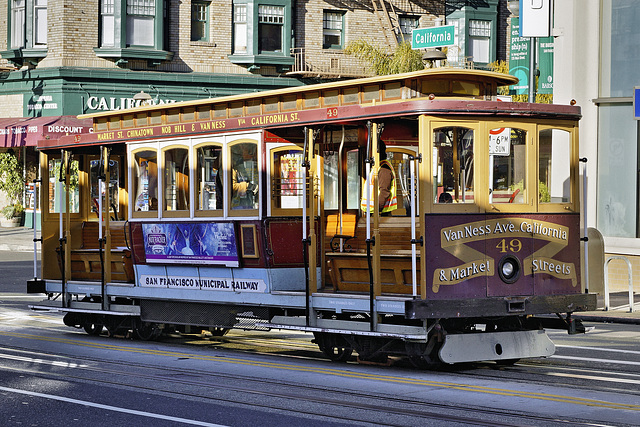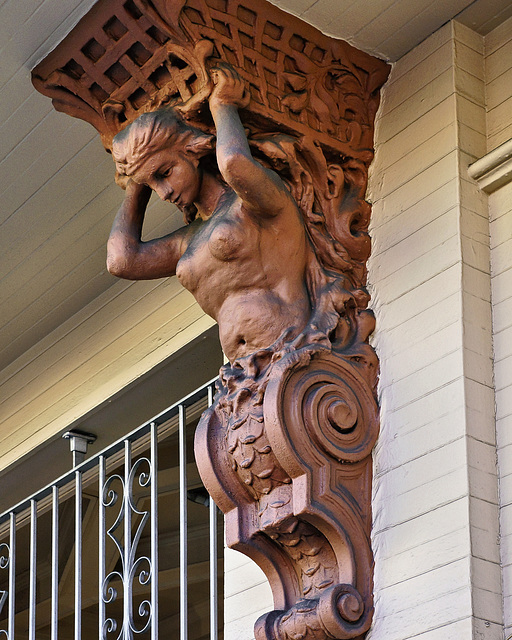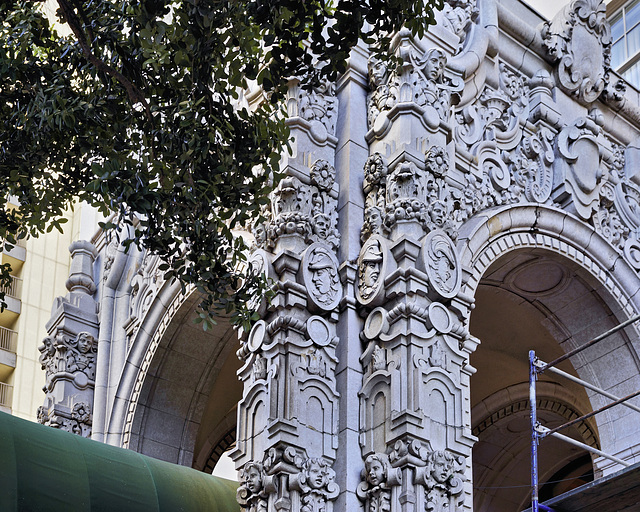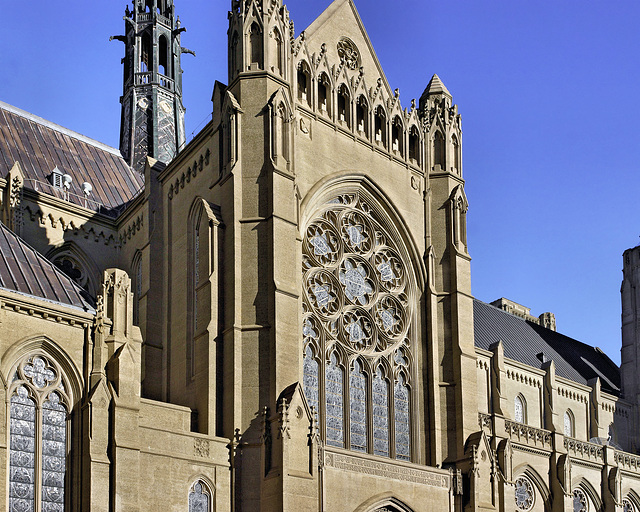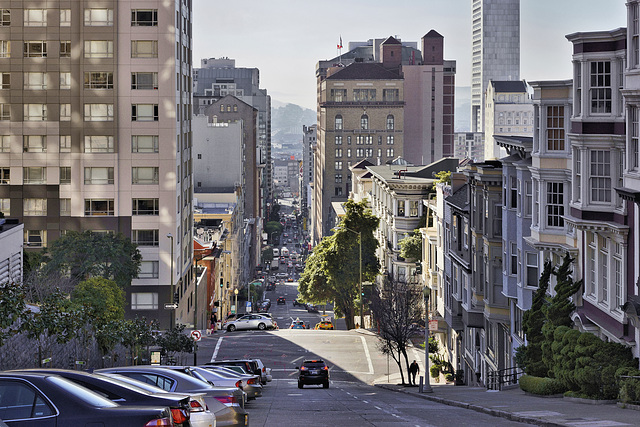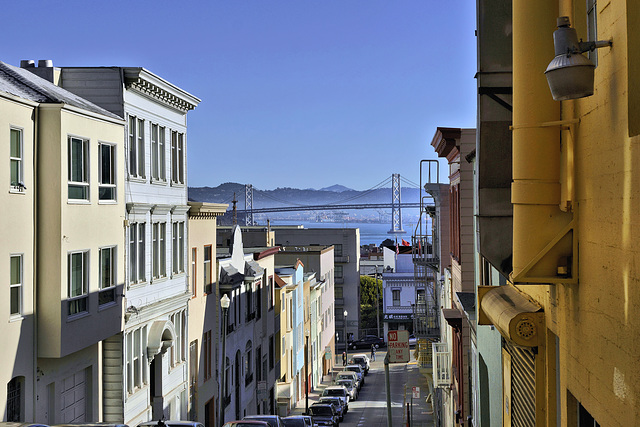
San Francisco, California
The Iconic Cable Car Shot – California Street at Polk, San Francisco, California
The San Francisco cable car system is the world’s last manually operated cable car system. An icon of San Francisco, California, the cable car system forms part of the intermodal urban transport network operated by the San Francisco Municipal Railway. Of the twenty-three lines established between 1873 and 1890, three remain (one of which combines parts of two earlier lines): two routes from downtown near Union Square to Fisherman’s Wharf, and a third route along California Street. While the cable cars are used to a certain extent by commuters, the vast majority of their 7 million annual passengers are tourists. They are among the most significant tourist attractions in the city, along with Alcatraz Island, the Golden Gate Bridge, and Fisherman’s Wharf. The cable cars are listed on the National Register of Historic Places.
Visible Means of Support – California Street between Polk and Larkin, San Francisco, California
The Cathedral Apartments – California Street at Jones Street, San Francisco, California
At the top of California Street sits the most stylish row of old apartment houses on Nob Hill. It starts at 1201 California, known as the Cathedral Building where Brigid O’Shaughnessy briefly stayed in in Dashiell Hammett’s book "The Maltese Falcon." (In the book the building is named the Coronet Hotel.)
Part of the fascination with The Maltese Falcon is Hammett’s vivid evocation of the city of San Francisco and his interweaving of actual locations with imaginative ones likely based on real addresses. In this case, the Coronet is an imaginative address, chosen as a swank location for the smooth facade Brigid projects. Crime author Joe Gores, writing in 1975 for the City of San Francisco magazine, tracks down the actual locations and models of settings in The Falcon, and convincingly argues that the Cathedral Building was the model for the Coronet. The building was constructed in 1929 and is the work of the architectural firm of Weeks & Day who also designed the Mark Hopkins hotel in San Francisco and the historic California Theater in San Jose.
Grace Cathedral, #1 – California Street, San Francisco, California
Grace Cathedral is an Episcopal cathedral located on Nob Hill in San Francisco. It is the cathedral church of the Episcopal Diocese of California, once state-wide in area, now comprising parts of the San Francisco Bay Area. Its ancestral parish, Grace Church, was founded in 1849 during the California Gold Rush. The cathedral is the daughter of historic Grace Church. Mark Twain was to satirize the church’s efforts to find a short-term rector in the 1860s and 1870s. Among the short-term rectors were roll film inventor Hannibal Goodwin and James Smith Bush great-grandfather of former US President George H. W. Bush and great-great-grandfather of former US President George W. Bush.
The first little chapel was built in the gold rush year of 1849, and the imposing third church, for a time called Grace "Cathedral", was destroyed in the fire following the 1906 earthquake. The railroad baron/banker Crocker family gave their ruined Nob Hill property for a diocesan cathedral, which took its name and founding congregation from the nearby parish. Dean J. Wilmer Gresham nurtured the young cathedral and work began on the present structure in 1928. Designed in French Gothic style by Lewis P. Hobart, it was completed in 1964 as the third largest Episcopal cathedral in the United States.
Laid out on the floor of Grace Cathedral is a labyrinth that is based on the famous medieval labyrinth of Cathédrale Notre-Dame de Chartres (The Cathedral of Our Lady of Chartres) located in Chartres, France. It is said that if a visitor walks the pattern of the labyrinth it will bring them to a meditative state. There is also another labyrinth outside of the cathedral in its courtyards.
Grace Cathedral, #2 – California Street, San Francisco, California
Grace Cathedral is an Episcopal cathedral located on Nob Hill in San Francisco. It is the cathedral church of the Episcopal Diocese of California, once state-wide in area, now comprising parts of the San Francisco Bay Area. Its ancestral parish, Grace Church, was founded in 1849 during the California Gold Rush. The cathedral is the daughter of historic Grace Church. Mark Twain was to satirize the church’s efforts to find a short-term rector in the 1860s and 1870s. Among the short-term rectors were roll film inventor Hannibal Goodwin and James Smith Bush great-grandfather of former US President George H. W. Bush and great-great-grandfather of former US President George W. Bush.
The first little chapel was built in the gold rush year of 1849, and the imposing third church, for a time called Grace "Cathedral", was destroyed in the fire following the 1906 earthquake. The railroad baron/banker Crocker family gave their ruined Nob Hill property for a diocesan cathedral, which took its name and founding congregation from the nearby parish. Dean J. Wilmer Gresham nurtured the young cathedral and work began on the present structure in 1928. Designed in French Gothic style by Lewis P. Hobart, it was completed in 1964 as the third largest Episcopal cathedral in the nation.
Laid out on the floor of Grace Cathedral is a labyrinth that is based on the famous medieval labyrinth of Cathédrale Notre-Dame de Chartres (The Cathedral of Our Lady of Chartres) located in Chartres, France. It is said that if a visitor walks the pattern of the labyrinth it will bring them to a meditative state. There is also another labyrinth outside of the cathedral in its courtyards.
The Pacific-Union Club – California Street, San Francisco, California
The Pacific-Union Club is a private social club located at 1000 California Street in San Francisco, California, at the top of Nob Hill. It was founded in 1889 as a merger of two earlier clubs: the Pacific Club (founded 1852) and the Union Club (founded 1854).
The clubhouse was built as the home for the silver magnate James Clair Flood. The former Flood Mansion is located in the Nob Hill neighborhood. It was designed by Willis Polk. It is considered the first brownstone constructed west of the Mississippi River. Along with the Fairmont Hotel across the street, it was the only structure in the area to survive the San Francisco earthquake and fire of 1906.
This club figured prominently in the history of the west coast of the United States. Many prominent citizens have been active among its membership. To this day, the club’s membership remains all male per its charter.
Looking Down Nob Hill – Mason Street below California Street, San Francisco, California
Nob Hill is a neighborhood in San Francisco, California, centered on the intersection of California Street and Powell Street. It is an affluent district, home to many of the city’s upper-class families as well as a large young urban professional population, and a growing Chinese immigrant population from Chinatown to the east. Nob is disparaging British slang abbreviation of "noble/nobility" referring to newly rich. The location is also derisively referred to as Snob Hill.
It is one of San Francisco’s 44 hills, and one of its original "Seven Hills." Prior to the 1850s, Nob Hill was called California Hill (after California Street, which climbs its steep eastern face). It was renamed after the Central Pacific Railroad’s Big Four – called the Nobs – built mansions there. The area was settled in the rapid urbanization happening in the city in the late 19th century. Because of the views and its central position, it became an exclusive enclave of the rich and famous on the west coast who built large mansions in the neighborhood. This included prominent tycoons such as Leland Stanford, founder of Stanford University and other members of The Big Four. For this reason, its early citizens were known as nabobs, which was shortened to nob, giving the area its eventual name. The neighborhood was destroyed in the 1906 earthquake and fire, except for the granite walls surrounding the Stanford, Crocker, Huntington and Hopkins mansions. Those walls remain and you can see black scars caused by smoke from the intense fires that burned after the quake.
While the neighborhood was able to maintain its affluence following the quake, every mansion owner moved or rebuilt elsewhere. Some rebuilt mansions further west in San Francisco, for example, in Pacific Heights and Cow Hollow. In place of where the mansions had been located, swank hotels were erected. Hotels built over the ruins of the former mansions include the Mark Hopkins, Huntington and Stanford Court.
The Oakland Bay Bridge – Seen from John Street, San Francisco, California
Nuestra Señora de Guadalupe Church – Broadway and Mason Street, San Francisco, California
From a piece by journalist Jesus Varela that appeared on the San Francisco Remexcla website:
There has been news regarding the public outcry over the potential sale of the Church of Nuestra Señora de Guadalupe. At the heart of the controversy is a decade’s old struggle by parishioners to preserve the historic landmark. The church, located in Russian Hill on the corner of Broadway and Mason St. was closed, along with a few others, in 1992 during a period when the Archdiocese of California was engrossed in an embezzlement scandal and declining membership. When it was discovered that the archdiocese was planning on selling the property, the former parishioners including elderly Catholic Mexican ladies marching downtown to the cathedral on their grandsons’ arms came together to save the church by preserving the structure as a San Francisco Historical Landmark in 1993; since then, the community of former parishioners has been requesting that the Archdiocese of California attempt to work with them to return the church to the community.
The archdiocese resisted, and instead allowed the property to be the temporary location of the St. Mary’s Chinese School (whose building was damaged in the 1989 Loma Pierta earthquake) with the assurance to former parishioners that once the church was made vacant, it would be restored and returned to the community (a process that lasted until June 2011). However, on November 19, 2010 the Archdiocese quietly placed the property on the market creating uproar from former parishioners and others in the community who wanted to preserve the church as a cultural landmark rather than watch it be sold and possibly demolished. The Archdioseses response: "We understand that people are going to be upset about this […] There are strong emotional connections. But we have to move on […] There are numerous other parishes named after our Blessed Mother that our Mexican-Latin-American communities should attend."
"So, the archdiocese wants to sell a church in Russian Hill that hasn’t had a mass in almost 20 years. What’s the big deal?" you ask. Well, many of you may not know this, but [gasp] The Mission hasn’t always been the Latino neighborhood of San Francisco. It wasn’t, really, until about the 1940’s that the Mission’s demographics changed from primarily Irish, German, and Polish to one of largely Latino heritage. In fact, pretty much from the point The Treaty of Guadalupe was signed, the "Latin Quarter" of San Francisco was based largely in the area that is now known as North Beach and the eastern part of Russian Hill.
At the heart of this neighborhood, which was also erroneously referred to as "Little Mexico," was Nuestra Señora de Guadalupe. Founded in 1875 via the collections and donations from parishioners, lots at 908 & 910 Broadway were purchased with the intention of constructing a church in which they could hear mass in Spanish. Following the 1906 earthquake, it was practically destroyed in the resulting fire. The only part of the original that still remains is framed image of our La Virgin that survived because a young Mexican couple rescued and buried it in the ground. The newly rebuild Nuestra Señora de Guadalupe became the anchor of a thriving Latino neighborhood throughout the first half of the 20th Century. A city guide book from 1940’s even describes the area Latin Quarter in this colorful way: "Although a common religion is their strongest bond with the immediate neighbors, Nuestra Señora de Guadalupe differs in aspect form the Italian church which overlooks Washington Square. Along the base of Russian Hill they have also their restaurants and social clubs, their abarrotes which offer Mexican candies, pasty, huaraches, and pottery. Spanish phonograph records are sold in a store which displays Spanish books, South American and Mexican periodicals, and American "pulp" magazines printed in Spanish."
The Church went through an age of splendor in this period, developing a highly respected musical program known for its brilliant pipe organ and talented choir. It even hosted a free performance by the famed Opera singer Luisa Tetrazzini shortly after her famous Christmas eve performance in 1910.
The same 1940’s guidebook describes the beautiful interior in the following way: "By day, light streams through stained-glass windows portraying the miracle at Guadalupe and the Sermon on the Mount; by night, from massive and ornate candelabra." It then continues to describe in this manner a fresco of the Holy Sacrament and the Coronation of the Blessed Virgin on the ceiling, a white marble altar, and a mural depicting the last supper which can be found at the end of the exquisitely tiled main aisle.
The growing Italian and Chinese populations throughout the early 20th began to make their mark in the area, and by the 1950’s the construction of the Broadway Tunnel had a devastating effect on the remaining community displacing many homes and stores and ushering in the migration of Latinos to the more affordable Mission district culminating with the eventual closing of the Church in the 1990’s.
But for many people Nuestra Señora de Guadalupe is more than just another church, it is the only remaining structure in San Francisco built by Mexicans. It is a historical reminder that Mexican’s have been in San Francisco since before the American invasion of Mexico, and have continued to make cultural contributions ever since – a fact that seems to get lost in the discussion of the history of SF. In many city guides, and even Wikipedia, the Latino population is simply portrayed as sort of just appearing in the Mission District in the 40’s
Jump to top
RSS feed- Latest items - Subscribe to the latest items added to this album
- ipernity © 2007-2024
- Help & Contact
|
Club news
|
About ipernity
|
History |
ipernity Club & Prices |
Guide of good conduct
Donate | Group guidelines | Privacy policy | Terms of use | Statutes | In memoria -
Facebook
Twitter

